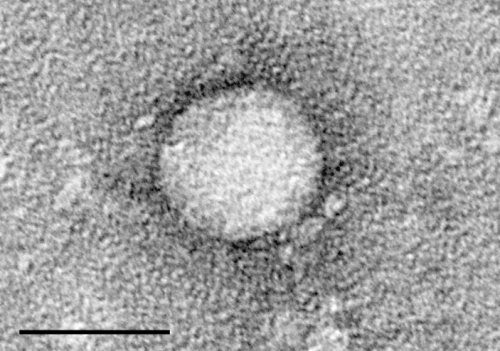Electron micrographs of hepatitis C virus purified from cell culture. Scale bar is 50 nanometers. Credit: Center for the Study of Hepatitis C, The Rockefeller University.
A group of Brazilian scientists has achieved promising results using isolated compounds from the venom of the South American rattlesnake to combat hepatitis C. The investigation was based on records in scientific literature in which animal venom showed activity against some viruses, such as yellow fever, measles and dengue, which belongs to the same Flaviviridae virus family as hepatitis.
There is a great need for new methods in the fight hepatitis C. The therapies available are expensive, have adverse side effects, and entail viral resistance. In Sao Paulo State, Brazil, some 50 percent of liver transplants are performed on hepatitis B or C patients, according to the state's health department. Hepatitis C patients alone account for 40 percent of all liver transplants in São Paulo.
The researchers tested three compounds from the venom of Crotalus durissus terrificus rattlesnake, and also investigated the antiviral potential of flavonoids extracted from Pterogyne nitens, a kind of plant endemic to Brazil. Results from these experiments were published in PloS One and Scientific Reports, respectively.
In the Laboratory of Toxicology at FCF-USP, two proteins from the rattlesnake venom were successfully isolated: phospholipase A2 (PLA2-CB) and crotapotin (CP). They are found in nature as subunits of the crotoxin protein complex, which the researchers also tested.
In a series of in vitro experiments with cultured human cells, they tested the antiviral action of the two compounds, both separately and together in the protein complex. They observed the compounds' effects on human cells (to prevent infection by the virus) and directly on hepatitis C virus.
The hepatitis C virus genome consists of a single strand of RNA (ribonucleic acid), which is a simple chain of nucleotides encoding the proteins in the virus. "This virus invades the human host cell to replicate, producing new viral particles. Inside the host cell, the virus produces a complementary strand of RNA, from which molecules of viral genome will emerge to constitute the new particles," said Ana Carolina Gomes Jardim, head of the Virology Laboratory in ICBIM-UFU.
"Our research showed that phospholipase can intercalate into double-stranded RNA, a virus replication intermediate, inhibiting the production of new viral particles. Intercalation reduced these by 86 percent compared with their production in the absence of phospholipase." When the same experiment was performed using crotoxin, production of viral particles fell 58 percent.
The second stage of the research consisted of verifying whether the compounds blocked the virus's entry into cultured human cells. In this case, the results were even more satisfactory: Phospholipase blocked 97 percent of viral cell entry, and crotoxin reduced viral infection by 85 percent.
Lastly, they tested crotapotin, another compound isolated from the same rattlesnake's venom. Crotapotin had no inhibitory effect on viral entry or replication, but did affect another stage of the virus's life cycle, reducing the release of new viral particles from cells by 78 percent. Treatment with crotoxin achieved 50 percent inhibition of viral release.
According to the researchers, the results of the experiments show that phospholipase and crotapotin produced better results when used separately than together.
Brazilian flora
The second article on the action of chemical compounds against hepatitis C virus describes substances derived from Brazilian flora: sorbifolin and pedalitin, both flavonoids isolated from the leaves of Pterogyne nitens during the experiments conducted by Professor Luis Octávio Regasini at UNESP's Green & Medicinal Chemistry Laboratory in Sao José do Rio Preto.
Flavonoids are compounds found in fruit, flowers, vegetables, honey and wine. As with the compounds isolated from rattlesnake venom, the flavonoids were tested for antiviral action in human cells infected with hepatitis C virus and in uninfected cells. "Sorbifolin blocked viral entry into human cells in 45 percent of cases, while pedalitin provided more promising results, blocking entry in 79 percent of cases. The experiment was performed with two genotypes of hepatitis C virus: genotype 2A, the standard type in all studies, and genotype 3, the second most prevalent in Brazil. In both cases, the antiviral action of the flavonoids was equivalent," Gomes Jardim said.
At the other end of the viral life cycle, the flavonoids had no effect on viral particle replication and did not prevent their release from infected cells.
"The flavonoids from P. nitens are among some 200 tested compounds isolated from Brazilian plants or synthesized using natural structures by Professor Regasini," said Paula Rahal, who coordinates the Virology Group at the Genomic Studies Laboratory at IBILCE-UNESP. "These two flavonoids were tested against hepatitis C virus because they'd been shown to have antiviral action in experiments with dengue virus."
More information: Jacqueline Farinha Shimizu et al, Multiple effects of toxins isolated from Crotalus durissus terrificus on the hepatitis C virus life cycle, PLOS ONE (2017). DOI: 10.1371/journal.pone.0187857
Journal information: Scientific Reports , PLoS ONE
Provided by FAPESP




















